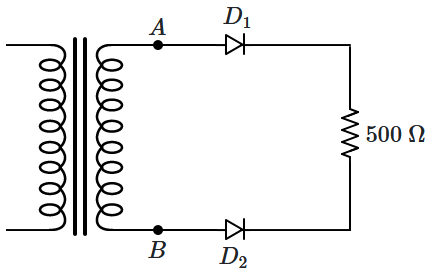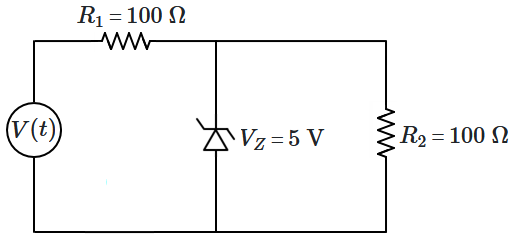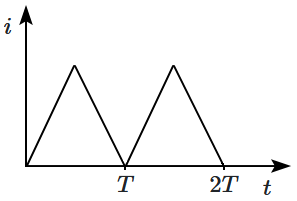The voltage \(V_{AB}=20~\text{V}\) at its peak value, and is sinusoidal in time. The current \(i\) (in amperes), when plotted as a function of time, is given by:
(consider the diodes as ideal.)

1.

2.

3.

4.






To unlock all the explanations of this course, you need to be enrolled.

To unlock all the explanations of this course, you need to be enrolled.

| 1. | \(V_o=V_i+E\) |
| 2. | \(V_o=V_i-E\) |
| 3. | \(V_o=V_i,\) only when \(V_i>E\) |
| 4. | \(V_o=V_i,\) only when \(V_i<E\) |

To unlock all the explanations of this course, you need to be enrolled.

To unlock all the explanations of this course, you need to be enrolled.

1. \(V_A>V_B+V_0\)
2. \(V_A<V_B+V_0\)
3. \(V_A>V_B-V_0\)
4. \(V_A<V_B-V_0\)

To unlock all the explanations of this course, you need to be enrolled.

To unlock all the explanations of this course, you need to be enrolled.

| 1. | no current flows in the circuit |
| 2. | current flows anticlockwise |
| 3. | current flows clockwise |
| 4. | current only flows through \(D_2\) and not through \(D_1\) |

To unlock all the explanations of this course, you need to be enrolled.

To unlock all the explanations of this course, you need to be enrolled.
 1. zero
1. zero2. \(4~\text{mA}\)
3. \(2.5~\text{mA}\)
4. \(0.8~\text{A}\)

To unlock all the explanations of this course, you need to be enrolled.

To unlock all the explanations of this course, you need to be enrolled.
 1. zero
1. zero2. \(20\) mA
3. \(40\) mA
4. \(20\sqrt2\) mA

To unlock all the explanations of this course, you need to be enrolled.

To unlock all the explanations of this course, you need to be enrolled.

| 1. | AND | 2. | OR |
| 3. | NOR | 4. | XOR |

To unlock all the explanations of this course, you need to be enrolled.

To unlock all the explanations of this course, you need to be enrolled.

For the above circuit, the applied voltage \(V(t)\) is periodic and linear, and is shown by the waveform below:

The current flowing through \(R_2\) varies as:
| 1. |  |
2. |  |
| 3. |  |
4. |  |

To unlock all the explanations of this course, you need to be enrolled.

To unlock all the explanations of this course, you need to be enrolled.
1. AND
2. OR
3. XOR
4. none of the above

To unlock all the explanations of this course, you need to be enrolled.

To unlock all the explanations of this course, you need to be enrolled.

1. AND gate
2. OR gate
3. XOR gate
4. null gate (always zero)

To unlock all the explanations of this course, you need to be enrolled.

To unlock all the explanations of this course, you need to be enrolled.






